
The Lewis Center is celebrating 70 years of creative writing at Princeton with a yearlong series of public readings by award-winning writers who are program alumni or have served on the faculty.
Novelist Robert Stone, formerly a visiting fellow, and poet C.K. Williams, a current member of the faculty, were scheduled to read in November; poet Maxine Kumin and professor and novelist Joyce Carol Oates kicked off the series in October. Reading later this academic year will be novelist Russell Banks and his wife, the poet Chase Twichell; poet W.S. Merwin ’48; novelist Mona Simpson; and current faculty members Chang-rae Lee and Jeffrey Eugenides. Each session includes a brief reading by a current student.
Princeton’s creative writing program — which has produced such noted contemporary writers as novelists Jonathan Safran Foer ’99 and Jodi Picoult ’87 — is “unparalleled,” said Lee, the program’s director. University creative writing programs, he said, usually are created to offer master’s degrees in fine arts. “There are very few places that are constituted as creative writing programs for undergraduates,” he said. Like students in the country’s most famous graduate programs, undergraduates at Princeton participate in small workshops with renowned writers.
Each year more students apply for a spot in one of the program’s workshops in poetry, fiction, translation, and screenwriting than there are places available. To remedy that problem, Lee said, the program increased its hiring of visiting faculty over the last three years, and the number of sections has increased by 50 percent, to about 14 to 16 offerings a semester. This fall, a record 175 students are enrolled in creative writing workshops.
The program started in 1939; at the time, Dean of the College Christian Gauss thought Princeton did little to cultivate writers and other artists. The program’s mission — still true today — was to encourage undergraduates to work in the creative arts under the supervision of professionals. Poet and critic Allen Tate was appointed the first resident fellow in creative writing, and he soon invited another noted poet and critic, Richard P. Blackmur, to assist him. Blackmur took over the program in the 1940s, attracting as teachers a succession of poets, writers, and critics, including John Berryman and Philip Roth. Poet Edmund Keeley ’48, who directed the program from 1966 to 1981, introduced translation courses into the curriculum and pushed for more permanent tenured faculty appointments. More recent faculty members have included Toni Morrison, Edmund White, and Paul Muldoon.
Today, small workshop courses averaging eight to 10 students provide intensive feedback and instruction for both beginners and advanced writers. The workshop format — in which students share their work with other students, read literature, and have individual faculty conferences — was one of Keeley’s innovations. Keeley wanted to expose students to the process of writing and “how writers themselves think about literature and talk about it,” he said. The format drew on student interest in criticism from their peers: Students “like to hear what their contemporaries are thinking,” he said.
To earn a certificate in creative writing, students must produce a creative thesis, and each year 15 to 20 seniors work to complete a novel or collection of short stories, poems, or translations. Some students write two senior theses, if the creative thesis does not fulfill the requirements of the department in which they are concentrating.
Math major Josephine Wolff ’10 is working on a collection of short stories in addition to a thesis for the math department. After “stumbling into” a creative writing workshop her freshman year, Wolff decided to enroll in the program. She said she finds it “thrilling and stressful” working with writers like Oates and Lee because “they care a lot about our writing and they read it very carefully. They take it seriously and comment on it as if it’s important.”
Faculty members benefit from the workshop discussions as well, said Lee, whose novel The Surrendered will be published in March. “I am stimulated by the exuberance and eagerness ... of these young writers,” he said. “It always reminds me what is so exciting about writing and the art of writing.”
Creative Writing Alumni
Following is a partial list of writers who took part in the program or studied with its faculty members. They are pictured left to right, starting at the top:
WILLIAM MEREDITH ’40, Pulitzer Prize-winning poet
W.S. MERWIN ’48, celebrated poet and winner of two Pulitzer Prizes
GALWAY KINNELL ’48, Pulitzer Prize-winning poet
JANE HIRSHFIELD ’73, poet; her books include “After”
WALTER KIRN ’83, novelist, critic, and author of the memoir “Lost in the Meritocracy”
JODI PICOULT ’87, best-selling and prolific novelist
JONATHAN AMES ’87, novelist and essayist who has been called “New York’s gonzo scribe”
MOHSIN HAMID ’93, Pakistani-born novelist; his latest book is “The Reluctant Fundamentalist”
JONATHAN SAFRAN FOER ’99, best known for his debut novel, “Everything is Illuminated”














No responses yet